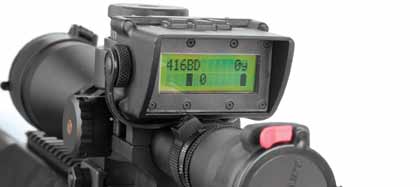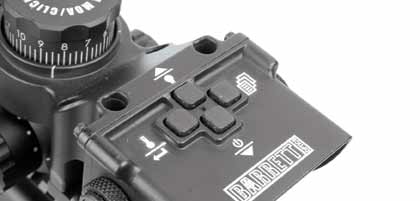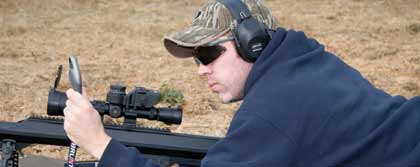September 23, 2010
By J. Guthrie
By J. Guthrie
Long-range shooting is an exact science, and the longer the range, the more exact the science.
Since the advent of the telescopic sight, optics have played a huge part in long-range shooting. They allow a marksman to better see a target and place bullets more precisely at distance.
Advertisement
The microchip has advanced the art to new heights. Laser rangefinders compute the exact distance in milliseconds, and palm-sized weather centers help establish atmospheric pressure, altitude, and wind speed. Ballistic computers in PDAs and even watches store tables and help shooters quickly compute drops and drifts. Gathering this information and entering it into a firing solution takes precious time, so innovators have always sought to speed up the process.
 The simple LCD screen displays the particular load, battery condition, the range, and whether or not the rifle is level. |
Barrett Firearms Manufacturing is a company well known for innovation, producing some of the first and best big-bore rifles capable of extreme long-range accuracy. Barrett's rifles were not tools searching for a job. Rather, they were purpose-built to satisfy specific needs.
Advertisement
Solving real-world problems is a hallmark of Barrett products. While new equipment and cartridges have made it possible to hit targets at extreme distances, it generally takes either several spotter shots or a few minutes of computing to come up with adjustments that put rounds on target. As with most targets of opportunity, neither spotter rounds nor precious minutes can be expended before taking a critical shot. The new Barrett Optical Ranging System (BORS) promises to provide a much faster way to arrive at a firing solution that allows a marksman to connect on his first shot.
I recently had the opportunity to examine and test a BORS unit, and here's what I learned about this unique little problem solver.
The BORS constantly monitors air temperature, barometric pressure, and angle of inclination. All the shooter has to do is enter the range, dope for wind, and squeeze the trigger. The unit replaces the top half of the rear ring and attaches directly to the "host" scope. An oversized knob replaces the scope's elevation turret and makes the elevation adjustments, but the scope retains its original windage and parallax adjustment knobs. A small LCD display sits just above the ocular lens, and when the elevation knob is turned, a corresponding range appears on the LCD screen. The shooter simply dials up the correct range, holds dead on, and squeezes the trigger.
Four operational keys are located on top of the housing and allow the user to maneuver through the various set-up menus, change units of measure, and adjust the LCD screen's contrast and backlighting. The keys also allow shooters to toggle between various loads stored in the computer. Waterproof, screw-on caps tethered to the unit cover both the computer port and battery compartment. All the controls are simple and intuitive.
A military sniper or prairie-dog shooter could travel from his home base a couple hundred feet above sea level to an Afghan or Wyoming mountain, set up, and shoot without computing the differences that elevation, temperature, and inclination will have on his bullet's point of impact. And he could do it from 100 yards out to the end of a cartridge's effective range. This eliminates the need for spotter shots and a double handful of little electric gizmos.
 The BORS has four buttons that allow the shooter to set up the unit, swap between preset loads, and adjust the LCD screen. |
The advantages to military marksmen are pretty obvious since the sound of .50-caliber spotter shots echoing through the mountains is a pretty big clue that a new kid is in town. Varmint or predator hunters do not have to fumble with calculations while a coyote slips over the hill and out of sight. The BORS exponentially increases the speed with which a marksman can make a shot and increases that first shot's accuracy since the opportunity to introduce human error is reduced.
The unit comes with 100 preset ballistic tables for commonly used long-range cartridges, including .50 BMG, .416 Barrett, .338 Lapua, .300 Winchester Magnum, .30-06, and .308 Winchester. More importantly, a new software program allows a shooter to create his own ballistic table for any cartridge/bullet/rifle combination and program the BORS with the information. The program needs the bullet weight, ballistic coefficient, muzzle velocity, and the optic's height above the bore line. Any caliber from .22 LR to .50 BMG using any bullet can use the system. The ballistic algorithms were developed from the work of several different ballisticians and data generated at Barrett. As long as the bullet is spinning and stable, the BORS can predict where it will hit.
As the name implies, there is a rangefinder function built into the BORS. The shooter has to preset a value from 1 to 20 feet or from 1/2 to 6 meters. The crosshair is then placed at the top or bottom of an object of known size--like a tank, a fence post, or a prairie dog--and the select button pressed. Using the elevation knob, the crosshair is moved to the opposite end of the target. Pressing the select button again yields the range, which is displayed on the LCD screen. The system is less accurate than a laser rangefinder and is meant as a backup in case a primary system fails.
Machined from an aluminum-alloy investment casting, the BORS is shockproof and waterproof. Its anodized finish and seals also pass salt-fog testing, and the system's electronics do not interfere with other sensitive gear. The lithium battery powers the unit for a minimum of 30 hours. It weighs just 13 ounces, and considering an M107 weighs around 30 pounds and the M99 weighs 25 pounds--sans scope--it is a small addition to an already substantial rifle. After more than four years of research and development, Barrett sent the BORS out for third party testing to make sure the unit was mil-spec tough.
 The wind value has to be determined and dialed into the scope bef ore taking the shot. |
Currently the BORS is designed to work with five different Leupold Mark IV scopes. Barrett is putting together units that work with NightForce, Schmidt & Bender, and additional Leupold models. Complete with rings, the unit retails for $1,500, or $2,700 with a Leupold scope.
Some quick testing with a Remington Model 700 Police in .308 Win. proved the BORS a simple and extremely fast way to hit targets at varying ranges. The rangefinder worked well on targets exactly 12 inches high, but steel plates proved a little more difficult to range. Ideally, a spotter with a high-quality laser rangefinder would do the ranging, providing more accurate data, and the shooter would not have to chase targets around the range.
Long-range shooting is fun for most of us and essential for the military. Learning the science behind it all is an essential component to actually hitting those tiny faraway targets. The Barrett BORS helps make that hit more certain, and makes it happen much faster.
